HONDA CIVIC SEDAN 2010 Owner's Manual (in English)
Manufacturer: HONDA, Model Year: 2010, Model line: CIVIC SEDAN, Model: HONDA CIVIC SEDAN 2010Pages: 387, PDF Size: 8.81 MB
Page 311 of 387
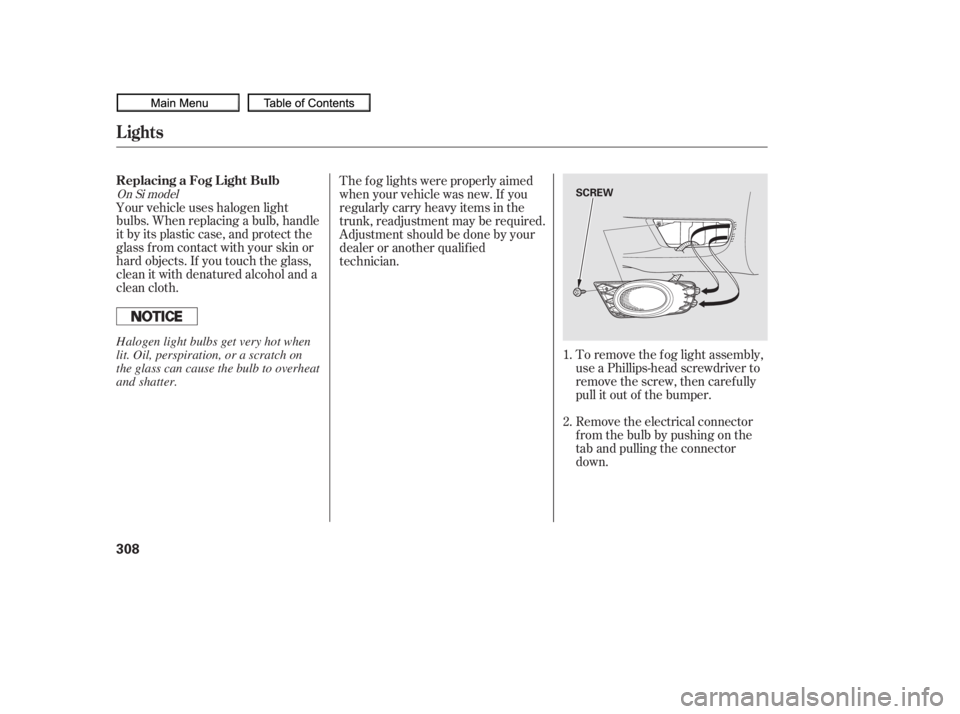
To remove the fog light assembly,
use a Phillips-head screwdriver to
remove the screw, then carefully
pull it out of the bumper.
Remove the electrical connector
f rom the bulb by pushing on the
tab and pulling the connector
down.
Your vehicle uses halogen light
bulbs. When replacing a bulb, handle
it by its plastic case, and protect the
glass from contact with your skin or
hard objects. If you touch the glass,
clean it with denatured alcohol and a
clean cloth.
Thefoglightswereproperlyaimed
when your vehicle was new. If you
regularly carry heavy items in the
trunk, readjustment may be required.
Adjustment should be done by your
dealer or another qualif ied
technician.
1.
2.
On Si model
Lights
ReplacingaFogLightBulb
308
SCREW
Halogen light bulbs get very hot when
lit. Oil, perspiration, or a scratch on
the glass can cause the bulb to overheat
and shatter.
09/07/02 17:20:26 31SNA640_313
Page 312 of 387
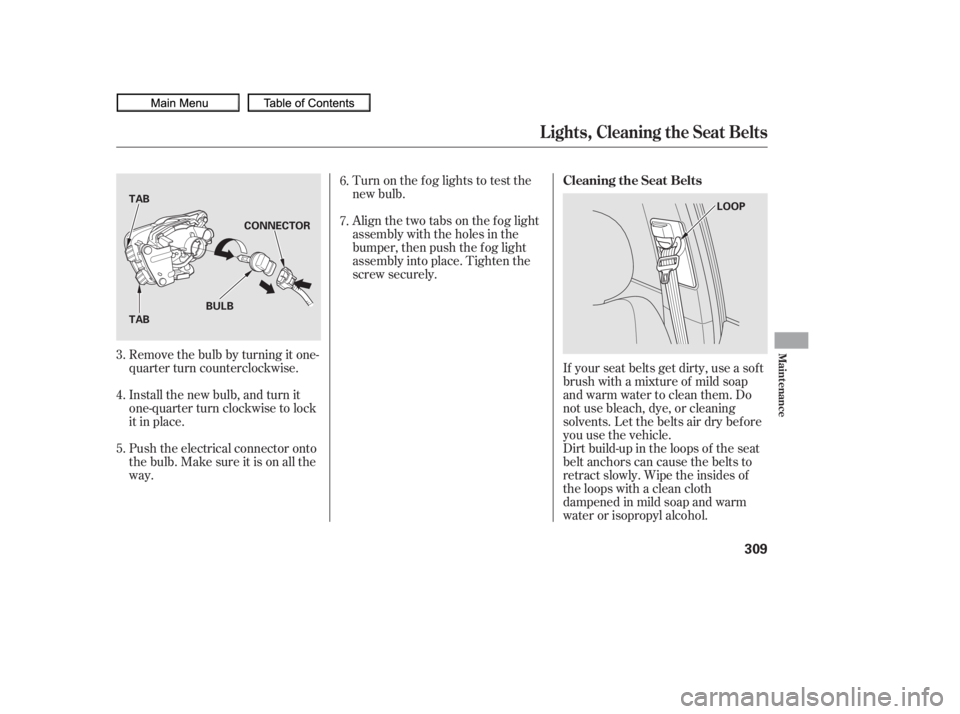
Turn on the f og lights to test the
new bulb.
Align the two tabs on the f og light
assembly with the holes in the
bumper, then push the f og light
assembly into place. Tighten the
screw securely.
Remove the bulb by turning it one-
quarter turn counterclockwise.
Install the new bulb, and turn it
one-quarter turn clockwise to lock
it in place.
Push the electrical connector onto
the bulb. Make sure it is on all the
way. If your seat belts get dirty, use a sof t
brush with a mixture of mild soap
and warm water to clean them. Do
not use bleach, dye, or cleaning
solvents. Let the belts air dry bef ore
you use the vehicle.
Dirt build-up in the loops of the seat
belt anchors can cause the belts to
retract slowly. Wipe the insides of
the loops with a clean cloth
dampened in mild soap and warm
water or isopropyl alcohol.
6.
7.
3.
4.
5.
Lights, Cleaning the Seat Belts
Cleaning the Seat Belts
Maint enance
309
TAB
TAB CONNECTOR
BULB LOOP
09/07/02 17:20:38 31SNA640_314
Page 313 of 387
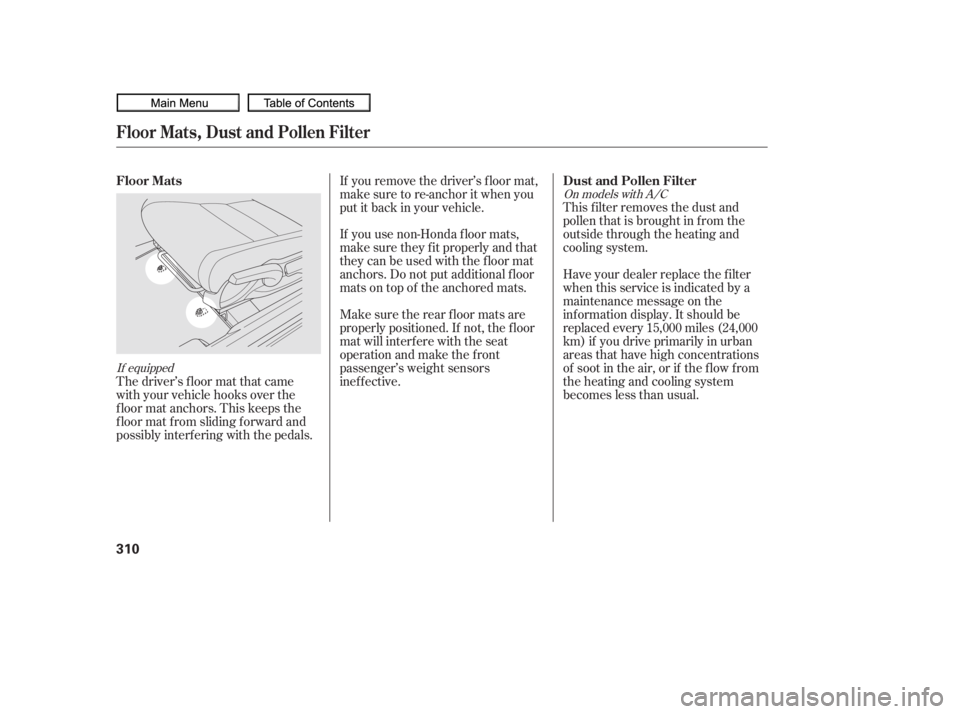
If equippedOn models with A/C
This f ilter removes the dust and
pollenthatisbroughtinfromthe
outside through the heating and
cooling system.
Have your dealer replace the filter
when this service is indicated by a
maintenance message on the
inf ormation display. It should be
replaced every 15,000 miles (24,000
km) if you drive primarily in urban
areas that have high concentrations
of soot in the air, or if the f low f rom
the heating and cooling system
becomeslessthanusual.
If you use non-Honda f loor mats,
make sure they f it properly and that
theycanbeusedwiththefloormat
anchors. Do not put additional f loor
mats on top of the anchored mats. If you remove the driver’s f loor mat,
make sure to re-anchor it when you
putitbackinyourvehicle.
The driver’s f loor mat that came
with your vehicle hooks over the
f loor mat anchors. This keeps the
f loor mat f rom sliding f orward and
possibly interf ering with the pedals. Make sure the rear f loor mats are
properly positioned. If not, the f loor
mat will interf ere with the seat
operation and make the f ront
passenger’s weight sensors
inef f ective.
Floor Mats
Dust and Pollen Filter
Floor Mats, Dust and Pollen Filter
310
09/07/02 17:20:48 31SNA640_315
Page 314 of 387
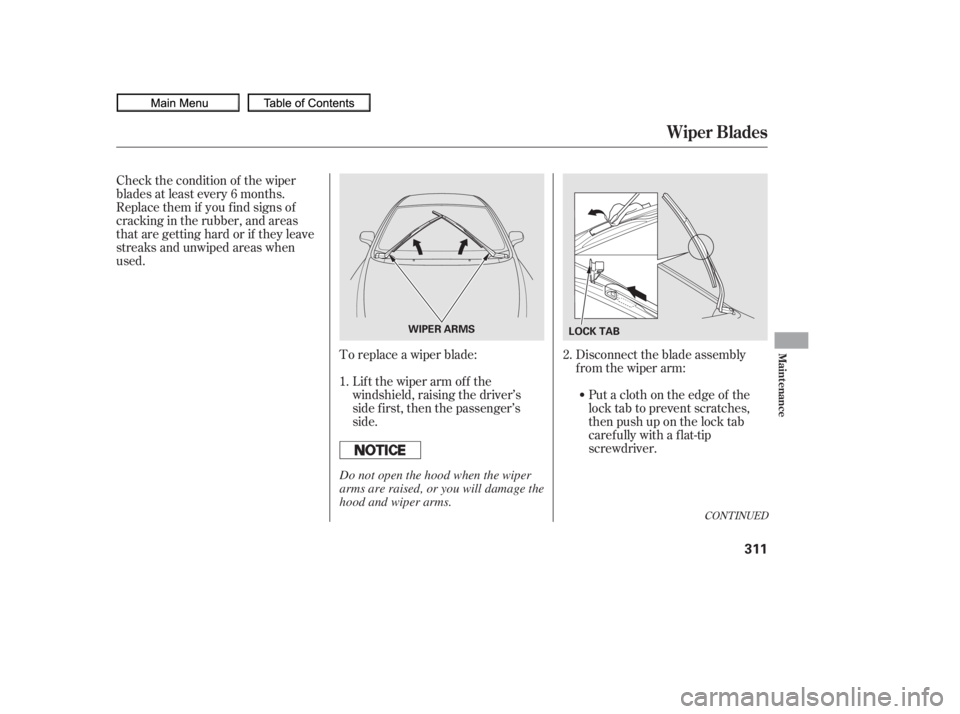
Check the condition of the wiper
blades at least every 6 months.
Replace them if you f ind signs of
cracking in the rubber, and areas
that are getting hard or if they leave
streaks and unwiped areas when
used.To replace a wiper blade:Lift the wiper arm off the
windshield, raising the driver’s
side first, then the passenger’s
side. Disconnect the blade assembly
from the wiper arm:
Put a cloth on the edge of the
lock tab to prevent scratches,
then push up on the lock tab
carefully with a flat-tip
screwdriver.
2.
1.
CONT INUED
Wiper Blades
Maint enance
311
WIPER ARMS LOCK TAB
Do not open the hood when the wiper
arms are raised, or you will damage the
hood and wiper arms.
09/07/02 17:20:58 31SNA640_316
Page 315 of 387
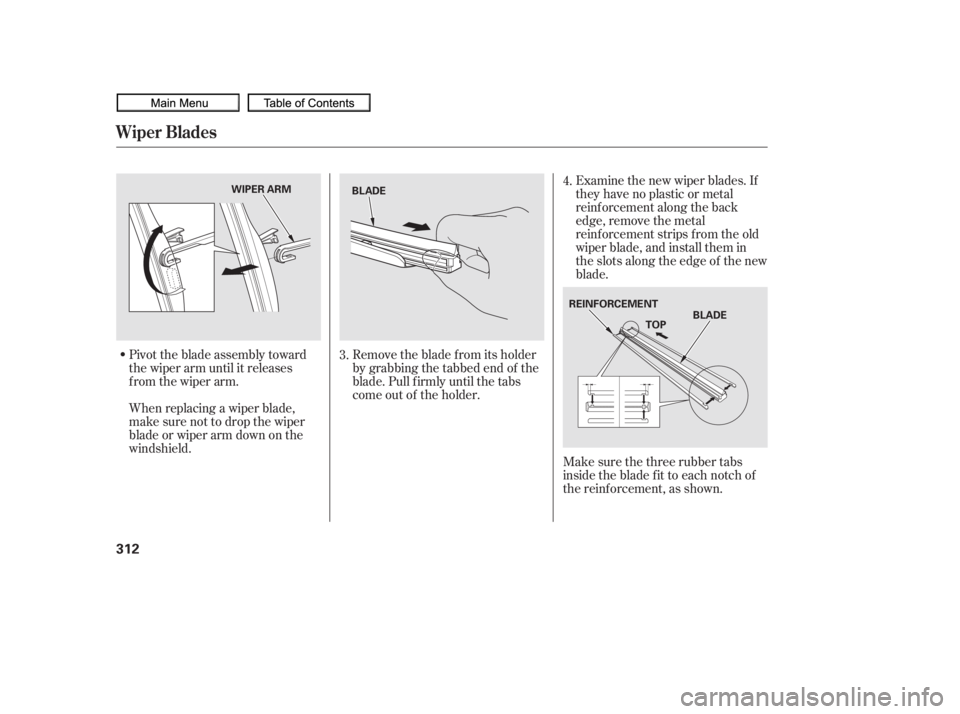
Pivot the blade assembly toward
the wiper arm until it releases
from the wiper arm.
When replacing a wiper blade,
make sure not to drop the wiper
blade or wiper arm down on the
windshield.Examine the new wiper blades. If
they have no plastic or metal
reinf orcement along the back
edge, remove the metal
reinf orcement strips f rom the old
wiper blade, and install them in
the slots along the edge of the new
blade.
Make sure the three rubber tabs
inside the blade f it to each notch of
the reinf orcement, as shown.
Remove the blade f rom its holder
by grabbing the tabbed end of the
blade. Pull f irmly until the tabs
come out of the holder.
3. 4.
Wiper Blades
312
BLADE
BLADE
REINFORCEMENT
WIPER ARM
TOP
09/07/02 17:21:07 31SNA640_317
Page 316 of 387
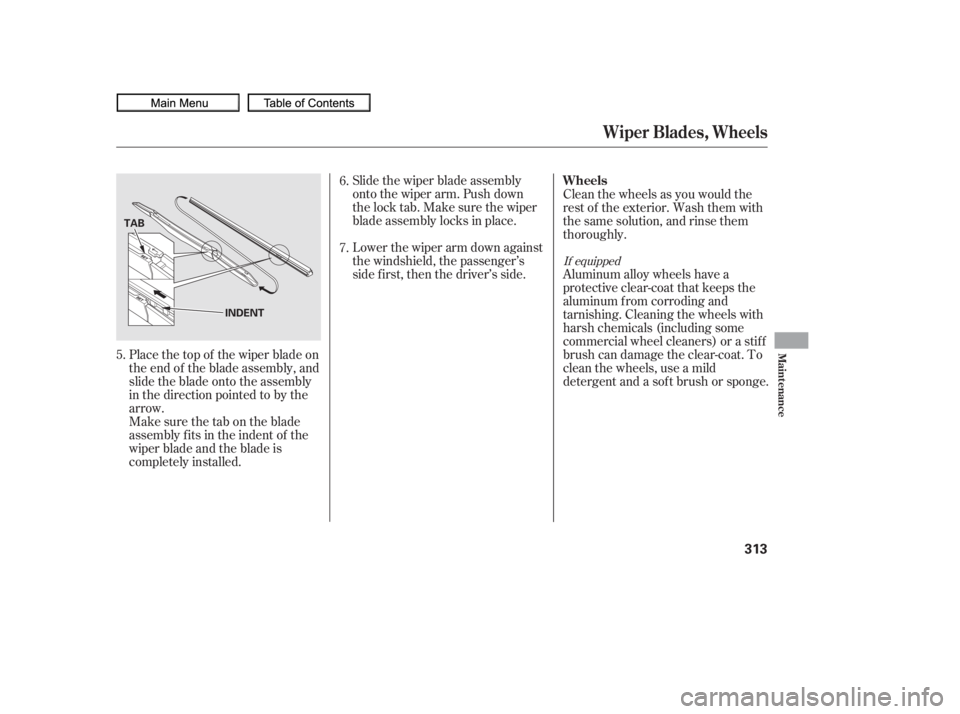
Place the top of the wiper blade on
the end of the blade assembly, and
slide the blade onto the assembly
in the direction pointed to by the
arrow.Slide the wiper blade assembly
onto the wiper arm. Push down
thelocktab.Makesurethewiper
blade assembly locks in place.
Lower the wiper arm down against
the windshield, the passenger’s
side first, then the driver’s side.
Make sure the tab on the blade
assembly fits in the indent of the
wiper blade and the blade is
completely installed. Clean the wheels as you would the
rest of the exterior. Wash them with
thesamesolution,andrinsethem
thoroughly.
Aluminum alloy wheels have a
protective clear-coat that keeps the
aluminum f rom corroding and
tarnishing. Cleaning the wheels with
harsh chemicals (including some
commercial wheel cleaners) or a stif f
brush can damage the clear-coat. To
clean the wheels, use a mild
detergent and a sof t brush or sponge.
5. 6.
7.
If equipped
Wiper Blades, Wheels
Wheels
Maint enance
313
INDENT
TAB
09/07/02 17:21:19 31SNA640_318
Page 317 of 387
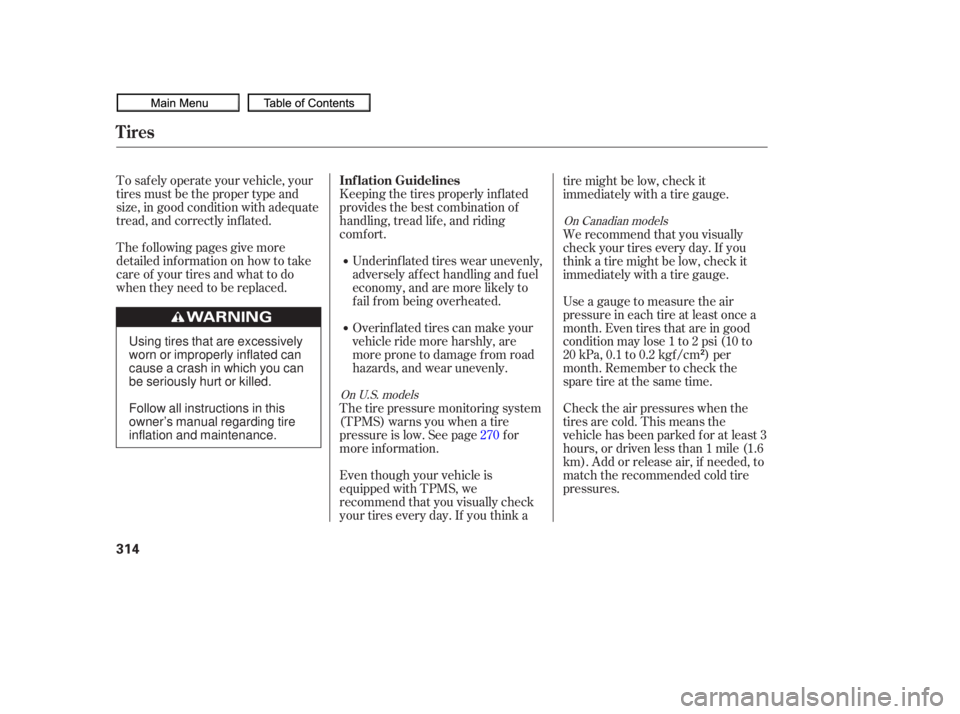
To saf ely operate your vehicle, your
tires must be the proper type and
size, in good condition with adequate
tread, and correctly inf lated.
The f ollowing pages give more
detailed inf ormation on how to take
care of your tires and what to do
when they need to be replaced.Keeping the tires properly inf lated
provides the best combination of
handling, tread lif e, and riding
comf ort.
Underinf lated tires wear unevenly,
adversely affect handling and fuel
economy, and are more likely to
fail from being overheated.
Overinf lated tires can make your
vehicleridemoreharshly,are
more prone to damage f rom road
hazards, and wear unevenly.
Thetirepressuremonitoringsystem
(TPMS) warns you when a tire
pressure is low. See page f or
more inf ormation.
Even though your vehicle is
equipped with TPMS, we
recommend that you visually check
your tires every day. If you think a tire might be low, check it
immediately with a tire gauge.
We recommend that you visually
check your tires every day. If you
think a tire might be low, check it
immediately with a tire gauge.
Use a gauge to measure the air
pressure in each tire at least once a
month. Even tires that are in good
condition may lose 1 to 2 psi (10 to
20 kPa, 0.1 to 0.2 kgf /cm ) per
month. Remember to check the
sparetireatthesametime.
Check the air pressures when the
tires are cold. This means the
vehicle has been parked f or at least 3
hours, or driven less than 1 mile (1.6
km). Add or release air, if needed, to
match the recommended cold tire
pressures.
270
On U.S. models On Canadian models
Tires
Inf lation Guidelines
314
Using tires that are excessively
worn or improperly inflated can
cause a crash in which you can
be seriously hurt or killed.
Follow all instructions in this
owner’s manual regarding tire
inflation and maintenance.
09/07/02 17:21:31 31SNA640_319
Page 318 of 387
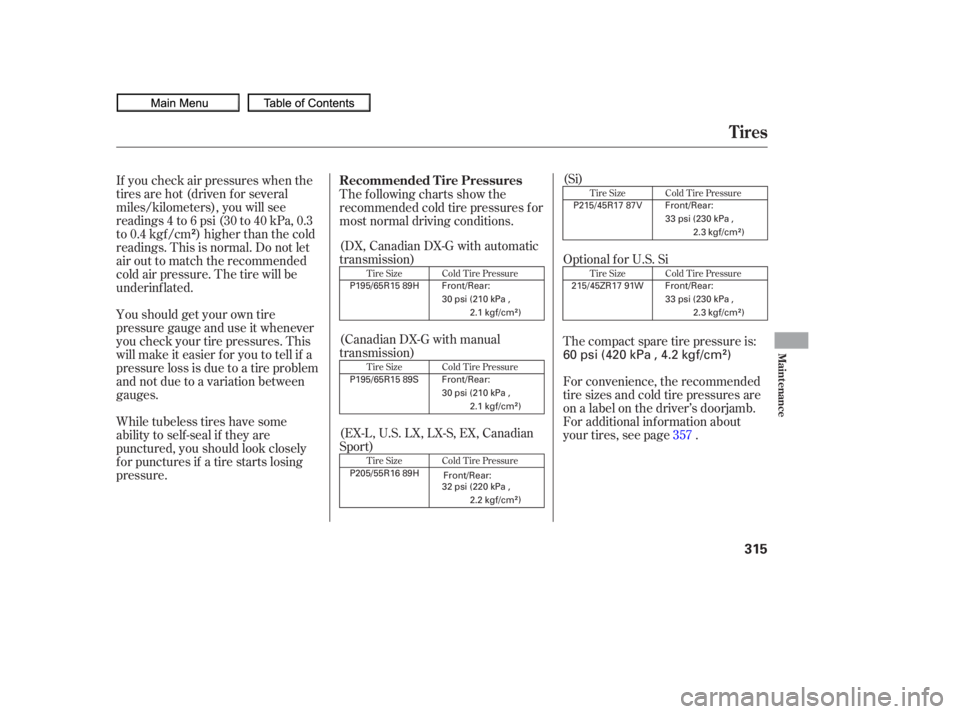
If you check air pressures when the
tires are hot (driven f or several
miles/kilometers), you will see
readings 4 to 6 psi (30 to 40 kPa, 0.3
to 0.4 kgf/cm ) higher than the cold
readings.Thisisnormal.Donotlet
air out to match the recommended
cold air pressure. The tire will be
underinf lated.
Youshouldgetyourowntire
pressure gauge and use it whenever
you check your tire pressures. This
will make it easier f or you to tell if a
pressure loss is due to a tire problem
and not due to a variation between
gauges.
While tubeless tires have some
ability to self -seal if they are
punctured, you should look closely
for punctures if a tire starts losing
pressure.The following charts show the
recommended cold tire pressures f or
most normal driving conditions.
Thecompactsparetirepressureis:
For convenience, the recommended
tire sizes and cold tire pressures are
on a label on the driver’s doorjamb.
For additional inf ormation about
your tires, see page . (Si)
(DX, Canadian DX-G with automatic
transmission)
(Canadian DX-G with manual
transmission)
(EX-L, U.S. LX, LX-S, EX, Canadian
Sport) 357
Optional f or U.S. Si
Tire Size Tire Size Cold Tire Pressure
Cold Tire Pressure
Tire Size Cold Tire Pressure
Tire Size Cold Tire Pressure
Tire Size Cold Tire Pressure
Tires
Recommended Tire Pressures
Maint enance
315
60 psi (420 kPa , 4.2 kgf/cm)
215/45ZR17 91W P215/45R17 87V
33 psi (230 kPa ,2.3 kgf/cm
)
33 psi (230 kPa , 2.3 kgf/cm
)
P195/65R15 89H
30 psi (210 kPa ,2.1 kgf/cm)
P195/65R15 89S 30 psi (210 kPa ,2.1 kgf/cm
)
P205/55R16 89H 32 psi (220 kPa ,2.2 kgf/cm
)
Front/Rear:
Front/Rear: Front/Rear:
Front/Rear:
Front/Rear:
09/07/02 17:21:51 31SNA640_320
Page 319 of 387
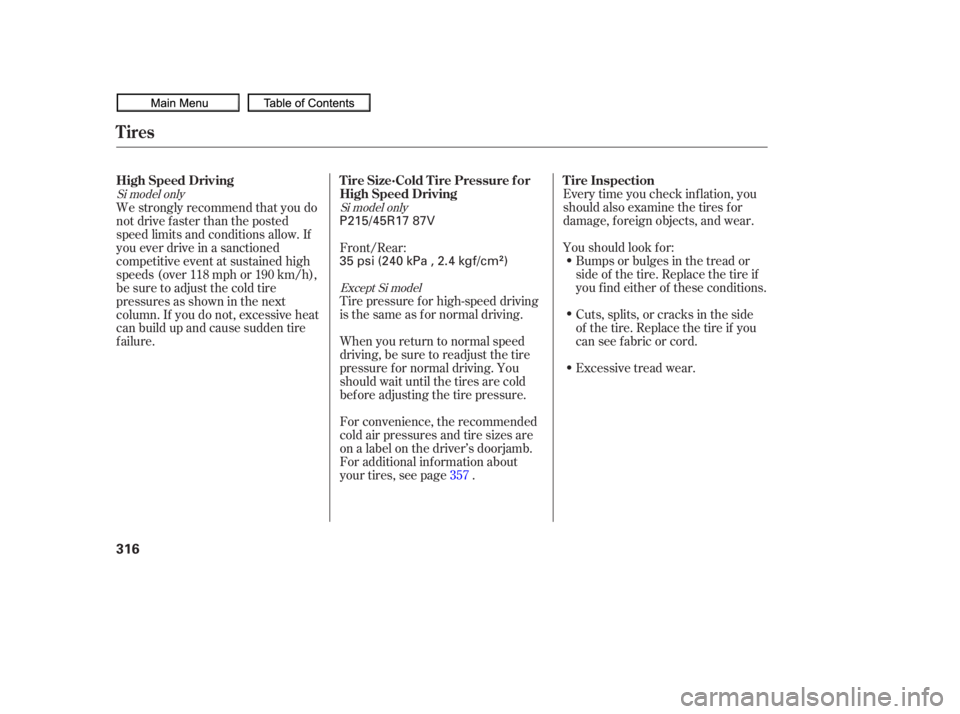
Every time you check inf lation, you
should also examine the tires for
damage, f oreign objects, and wear.
Youshouldlookfor:Bumps or bulges in the tread or
side of the tire. Replace the tire if
youfindeitherof theseconditions.
Cuts, splits, or cracks in the side
of the tire. Replace the tire if you
can see f abric or cord.
Excessive tread wear.
Tire pressure f or high-speed driving
is the same as f or normal driving.
When you return to normal speed
driving, be sure to readjust the tire
pressure f or normal driving. You
should wait until the tires are cold
bef ore adjusting the tire pressure.
For convenience, the recommended
cold air pressures and tire sizes are
on a label on the driver’s doorjamb.
For additional inf ormation about
your tires, see page .
We strongly recommend that you do
not drive faster than the posted
speed limits and conditions allow. If
you ever drive in a sanctioned
competitive event at sustained high
speeds (over 118 mph or 190 km/h),
be sure to adjust the cold tire
pressuresasshowninthenext
column. If you do not, excessive heat
can build up and cause sudden tire
f ailure.
Front/Rear:
357
Si model onlyExcept Si model
Si model only
Tires
Tire Inspection
Tire Size·Cold Tire Pressure f or
High Speed Driving
High Speed Driving
316
P215/45R17 87V
35 psi (240 kPa , 2.4 kgf/cm
)
09/07/02 17:22:02 31SNA640_321
Page 320 of 387
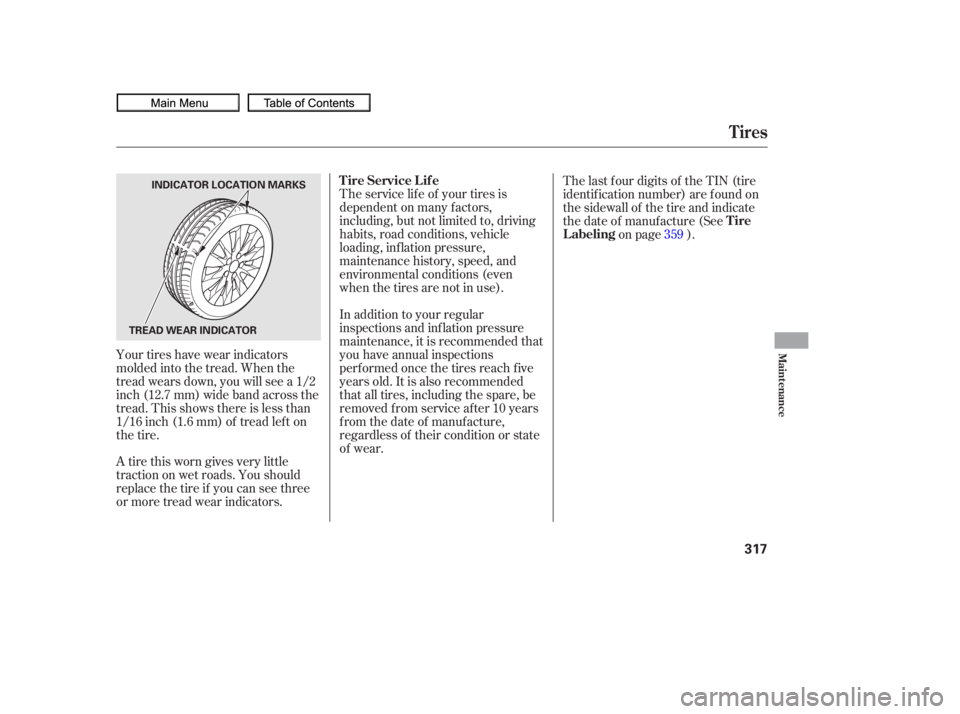
A tire this worn gives very little
traction on wet roads. You should
replace the tire if you can see three
or more tread wear indicators.The service lif e of your tires is
dependent on many f actors,
including, but not limited to, driving
habits, road conditions, vehicle
loading, inf lation pressure,
maintenance history, speed, and
environmental conditions (even
when the tires are not in use).
In addition to your regular
inspections and inf lation pressure
maintenance, it is recommended that
you have annual inspections
perf ormed once the tires reach f ive
years old. It is also recommended
that all tires, including the spare, be
removed from service after 10 years
from the date of manufacture,
regardless of their condition or state
of wear.
The last f our digits of the TIN (tire
identif ication number) are f ound on
the sidewall of the tire and indicate
the date of manufacture (See
on page ).
Your tires have wear indicators
molded into the tread. When the
tread wears down, you will see a 1/2
inch (12.7 mm) wide band across the
tread. This shows there is less than
1/16 inch (1.6 mm) of tread lef t on
the tire. 359
Tires
Tire Service Lif e
Tire
Labeling
Maint enance
317
TREAD WEAR INDICATOR INDICATOR LOCATION MARKS
09/07/02 17:22:11 31SNA640_322